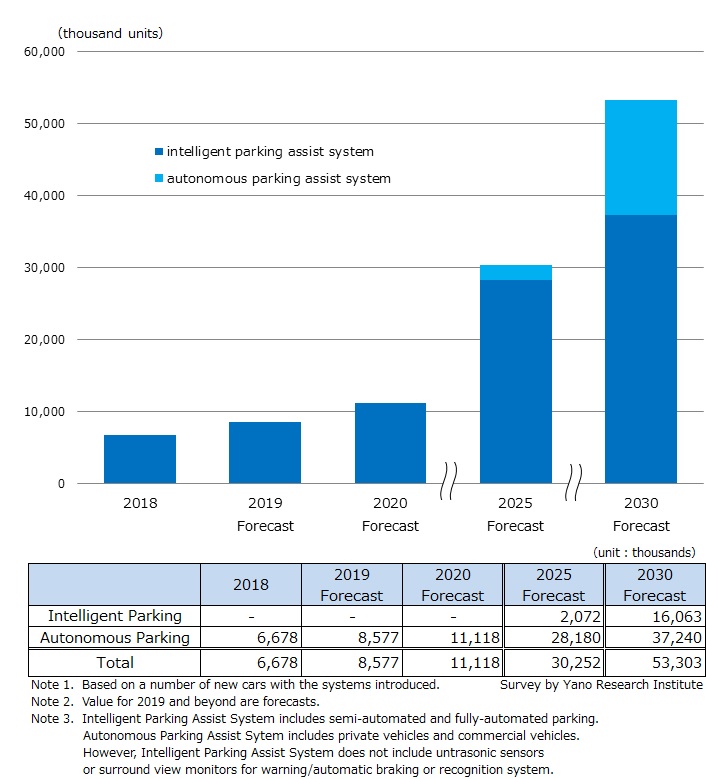No.2238
Global Intelligent Parking Assist System / Autonomous Parking System Market: Key Research Findings 2019
Number of New Cars with Intelligent Parking Assist System / Autonomous Parking System Projected to Reach 53.3 Million Units by 2030
Yano Research Institute (the President, Takashi Mizukoshi) has conducted a survey on the global intelligent parking assist system / autonomous parking system market, and found out the market overview on sensors (view cameras, ultrasonic sensors) installed as the intelligent parking assist system / autonomous parking system, the technological trends, the business strategy at manufacturers, and the forecast on the number of new cars with the intelligent parking assist system / autonomous parking system introduced by 2030.

Market Overview
In 2018, the global market size of parking assist system the number of new cars with the systems introduced) attained 6,678 thousand units. Among these, the parking assist system with automatic steering (including the number of units with semi-autonomous driving system or the system which automates both steering and braking) accounts for more than 80% of the market, while introduction of the system automating steering actions, braking, acceleration, and lever shifting (fully-autonomous driving) is on the moderate rise especially among the luxury class vehicles. For 2019, the number of cars with the systems introduced continued to increase; the outlook of the market size worldwide for the parking assist system (the number of new cars with the system introduced) is expected to reach 8,577 thousand units in 2019.
Noteworthy Topics
Progress in Practical Implementation of Sensor Fusion in Parking Assist System
Today, a sensor system for capturing spatial images (recognizing the parking space) in mass-produced parking assist system is using either the surround view cameras or the ultrasonic sensors.
The intelligent parking assist system using view cameras determines ‘white lines’ of the parking space. If the parking lot does not have white lines, the sensor does not activate; yet this is effective in Japan, where the white lines are mostly drawn in the parking lot. The ultrasonic sensor-based parking assist system captures other vehicles in the parking lot, and identifies the open area as a parking space. The system is useful in the parking lot without white lines or in the darkness; however, if there are no other vehicles parked, the system does not set off because it cannot recognize the parking space.
For these reasons, both methods have advantages and disadvantages; still, a ‘fusion system’ that integrates the two methods is becoming a practical in some vehicle types. While the ultrasonic sensors are being standardized for the “prevention of erroneous stepping (of accelerator and brake pedals)” and the “low speed AEB (Autonomous Emergency Braking)”, the introduction of ‘fusion system’ with ultrasonic sensors provided with additional information gathered by the surround view cameras is expected to increase.
Future Outlook
The number of new cars with the intelligent parking assist system / autonomous parking system worldwide is projected to reach 53,303 thousand units by 2030, the rate of new cars with the system introduced to rise to 40% mark. By segment, the figures are to expand to 37,240 thousand units for parking assist systems that are semi-autonomous or fully-autonomous, and 16,063 thousand units for the systems with no monitoring by the driver required (equivalent to the level 4 in SAE International classification of autonomous driving).
For 2023 and beyond, the vehicles with the parking assist system introduced are expected to increase in the countries such as Japan, US, Europe and China, and from 2025 and on, fully-autonomous system is projected to replace the semi-autonomous system. With a guideline by ISO (International Standardization Organization) for the self-parking system, and full-scale deployment of V2X (Vehicle to Everything) is likely to prevail from 2026, introduction of the parking system is expected to gather momentum for the commercial vehicles at classification level 4 of autonomous driving (car-share vehicles, public transportation buses, and delivery vehicles).
Research Outline
2.Research Object: Automakers, car electronics makers, semiconductors, sensor makers, etc.
3.Research Methogology: Face-to-face interviews by the expert researchers, surveys via telephone/email, and literature research.
Intelligent Parking Assist System / Autonomous Parking System Market
The intelligent parking assist system is a system which automates steering actions only, with a driver responsible for steering actions, acceleration, braking, and lever shifting. However, implementation of highly automated parking assist system is also starting, which enables full automation of all of such operations, requiring the driver to just ‘monitor’. Nevertheless, in this research, the intelligent parking assist system does not include the warning/automatic braking system or the recognition system using ultrasonic sensors or surround view monitors.
Meanwhile, the autonomous parking assist system requires no monitoring by drivers; it is a system that enables driver-less parking, in which the system determines a parking space and automatically parks the car after driver gets off the car (automated valet parking).
In this research, the market size is calculated based on the number of new cars with intelligent parking assist system / autonomous parking system introduced.
<Products and Services in the Market>
Intelligent parking assist / autonomous parking assist systems, rear view cameras, surround view cameras, ultrasonic sensors.
Published Report
Contact Us
The copyright and all other rights pertaining to this report belong to Yano Research Institute.
Please contact our PR team when quoting the report contents for the purpose other than media coverage.
Depending on the purpose of using our report, we may ask you to present your sentences for confirmation beforehand.